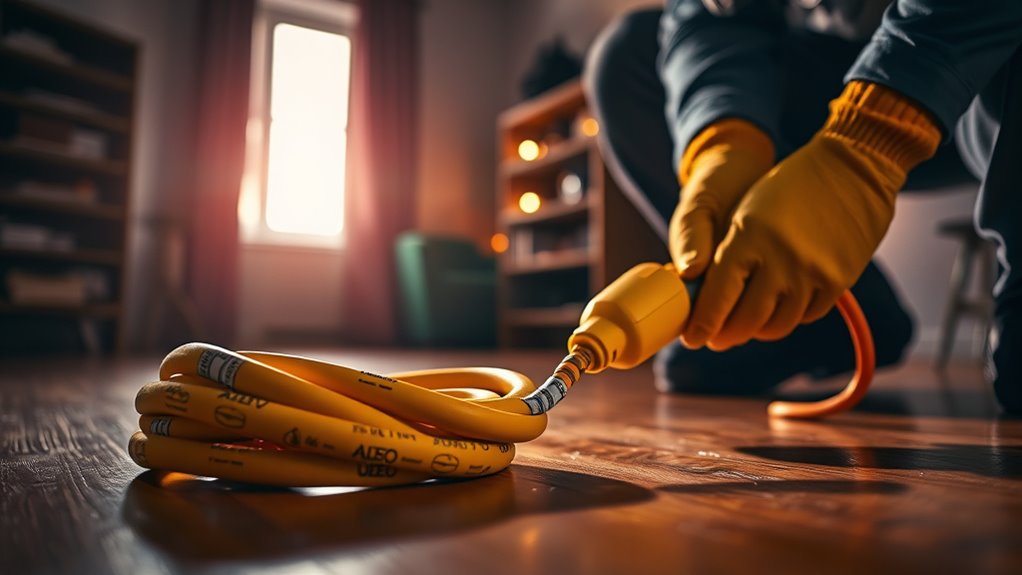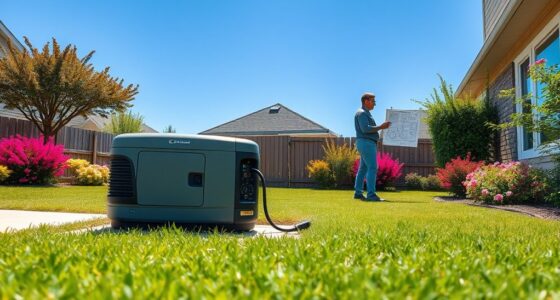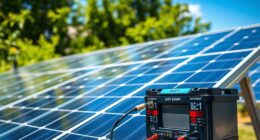During outages, safely using extension cords means selecting the right type, properly placing them away from water and high-traffic areas, and inspecting for damage before use. Keep cords uncoiled, avoid daisy-chaining, and disconnect by pulling the plug straight out. Proper storage and routine inspections are key to reliability. To guarantee your safety and power needs are met, learn more about best practices and backup options that keep you prepared during emergencies.
Key Takeaways
- Select appropriately rated, outdoor or indoor extension cords to prevent overheating and electrical hazards during outages.
- Keep cords uncoiled, elevated, and away from water or high-traffic areas for safety and reduced tripping risks.
- Regularly inspect cords for damage, frays, or wear before use to ensure safe operation during outages.
- Use short cords and avoid daisy-chaining multiple extensions to prevent overloads and electrical failures.
- Properly store cords in dry, cool places, label them for easy identification, and perform routine maintenance checks.
Understanding When and Why to Use Extension Cords During Power Outages
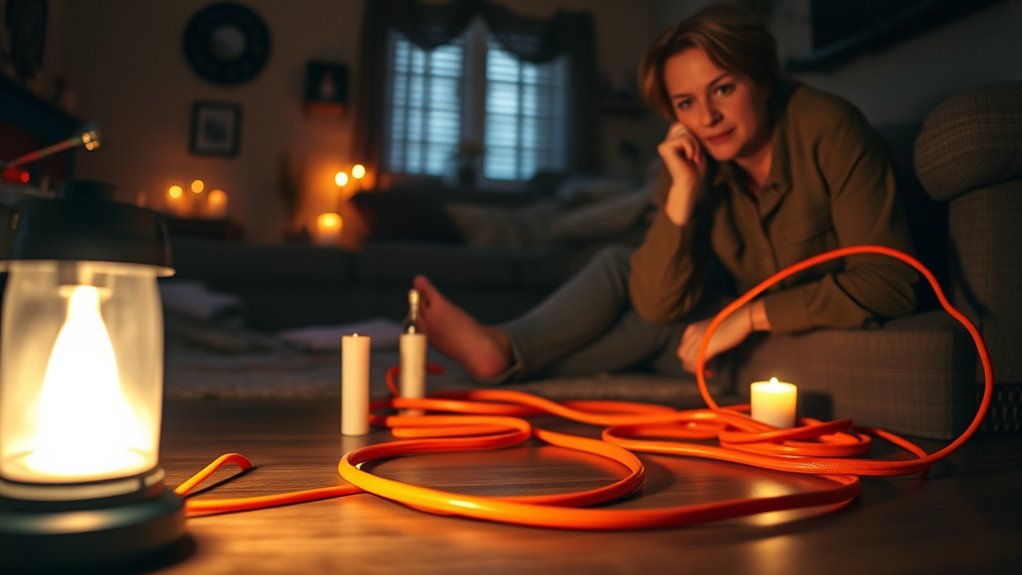
During power outages, knowing when and why to use extension cords is essential for safety and convenience. When indoor lighting is needed, extension cords allow you to power lamps and LED lights without moving furniture or risking unsafe setups. They’re also useful for appliance compatibility, ensuring essential devices like refrigerators or medical equipment stay operational. Use cords rated for indoor lighting to prevent overheating and electrical hazards. Always check that appliances are compatible with extension cords; high-wattage devices may require heavy-duty cords designed for their power needs. Properly placing extension cords avoids tripping hazards and keeps power flowing safely. Remember, the goal is to maintain safety while ensuring you have adequate lighting and functioning appliances during outages. Additionally, understanding and adhering to proper electrical safety protocols can further reduce risks during power disruptions.
Selecting the Right Extension Cord for Emergency Situations
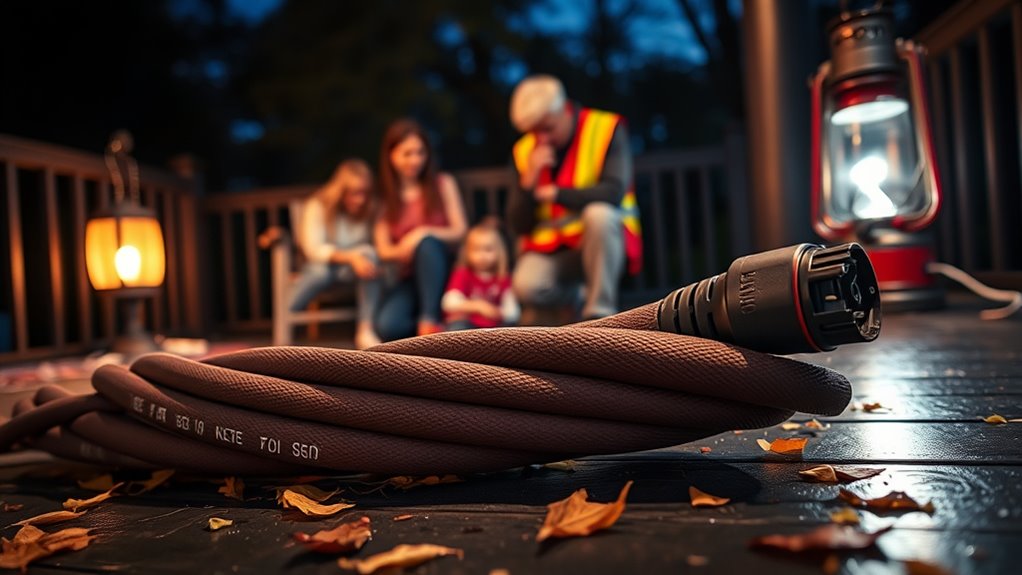
Choosing the right extension cord during emergency situations can make a significant difference in safety and effectiveness. First, consider the cord gauge; a lower gauge number means a thicker cord, which can handle more power and reduce the risk of overheating. For high-power devices, select a heavy-duty cord with a lower gauge, such as 12 or 14 gauge. Next, think about the cord length—use the shortest cord possible to minimize voltage drops and tripping hazards. Longer cords may be necessary, but avoid excessive length that can lead to power loss and safety issues. Always check that your extension cord is rated for outdoor use and suitable for the equipment you’re powering. Proper selection ensures safety, efficiency, and peace of mind during emergencies. Additionally, always inspect cords for damage or frays before use to prevent potential hazards related to safety standards.
Proper Placement and Setup of Extension Cords for Safety
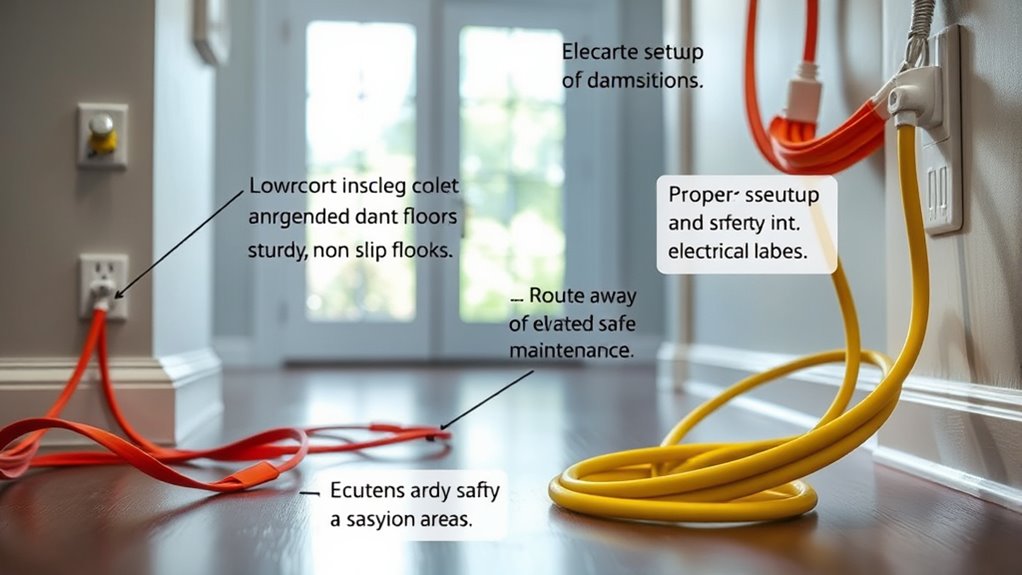
To guarantee safe use of extension cords, you should carefully position and set them up to prevent hazards. Keep cords uncoiled to avoid overheating and prevent tripping. When connecting portable generators, ensure cords run away from water and high-traffic areas. Use surge protectors with your devices or generators to prevent power surges that can damage equipment. Avoid pinched or damaged cords, and never force cords into tight spaces. Elevate cords over walkways to reduce tripping risks. When setting up near outdoor outlets or generators, ensure cords are rated for outdoor use to withstand weather conditions. Proper placement minimizes the risk of electrical shock or fire, especially during outages, and guarantees continuous, safe power supply to your essential devices. Additionally, choosing reliable outdoor-rated extension cords can significantly enhance safety and durability during emergency situations.
Avoiding Common Hazards and Mistakes With Extension Cords
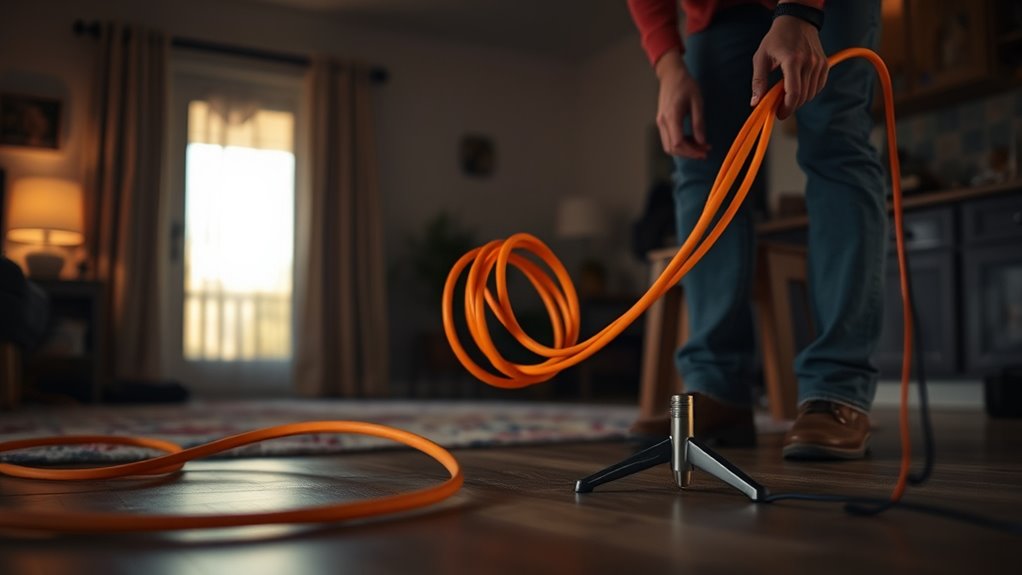
To stay safe during power outages, you need to choose the right extension cords and use them properly. Using cords that aren’t rated for your devices or overloading them can cause hazards. Make sure you select cords suited for your needs and follow safe usage practices at all times. Additionally, understanding the importance of high-quality projectors for gaming enthusiasts can ensure you have reliable equipment during emergency situations.
Proper Cord Selection
Selecting the right extension cord is essential for safety during power outages, as using an improper cord can lead to electrical hazards. Start by checking the cord insulation; it should be durable and rated for outdoor use if needed. The insulation protects against moisture, dirt, and physical damage. Next, pay attention to the cord gauge; a lower gauge number means a thicker cord that can handle higher current loads. For heavy appliances or multiple devices, choose a cord with a gauge suitable for the power requirements. Avoid using thin or damaged cords, as they pose fire and shock risks. Always pick a cord rated for the intended load and environment to guarantee safe operation during outages. Proper selection minimizes hazards and keeps you safe. Additionally, understanding outdoor electrical safety can help prevent accidents and ensure your setup is secure.
Safe Usage Practices
While extension cords are useful during outages, using them improperly can create serious hazards. To guarantee safety, always prioritize grounding safety by choosing cords with proper grounding plugs and avoiding damaged insulation. Be mindful of cord length considerations; using cords that are too long can lead to voltage drops, reducing power efficiency and increasing fire risk. Never overload a cord or connect multiple extension cords together, as this can cause overheating. Keep cords away from water, high traffic areas, and sharp objects to prevent damage and trips. Always inspect cords before use for cuts or frays. Proper grounding safety and careful selection of cord length help prevent electrical shocks and fires, keeping you and your household safe during outages. Additionally, selecting appropriate extension cords designed for the intended load can greatly enhance safety and performance.
Maintaining and Inspecting Extension Cords for Reliability

You should regularly inspect your extension cords for signs of damage or wear, like frayed wires or cracks. Proper storage, such as coiling cords loosely and keeping them in a dry place, helps prevent deterioration. Making these routines a habit guarantees your cords stay reliable when you need them most. Additionally, understanding the importance of fathers’ guidance and support can inspire you to prioritize safety and maintenance in all aspects of home care.
Regular Inspection Routines
Regular inspection of extension cords is essential to guarantee they remain safe and reliable during outages. Start by checking the cord’s condition—look for cuts, frays, or exposed wires. Ensure the plug and outlet connections are secure and free of damage. When inspecting cord storage, avoid tightly coiling cords, which can cause internal damage over time. Instead, store cords loosely to prevent stress on the cord length and reduce wear. Measure the cord length regularly to confirm it’s appropriate for your needs; a cord that’s too long or too short can lead to tripping hazards or inadequate reach. Additionally, regularly review projector bulb maintenance guidelines to ensure your equipment operates safely and efficiently during power outages. By routinely inspecting and maintaining your extension cords, you guarantee they perform safely and effectively whenever you need them most.
Proper Storage Practices
Proper storage is essential for maintaining extension cords’ safety and longevity. When you organize your cords, you reduce trip hazards and prevent damage. Use a dedicated storage area to keep cords untangled and protected from moisture or extreme temperatures. Proper storage organization helps you quickly find the right cord when you need it most. To enhance safety, label your cords clearly with cord labeling, indicating their purpose or power capacity. Keep these tips in mind:
- Store cords in a cool, dry place to avoid deterioration.
- Wrap cords neatly to prevent kinks and breaks.
- Label cords for easy identification and safe use.
Safe Practices for Connecting and Disconnecting Extension Cords
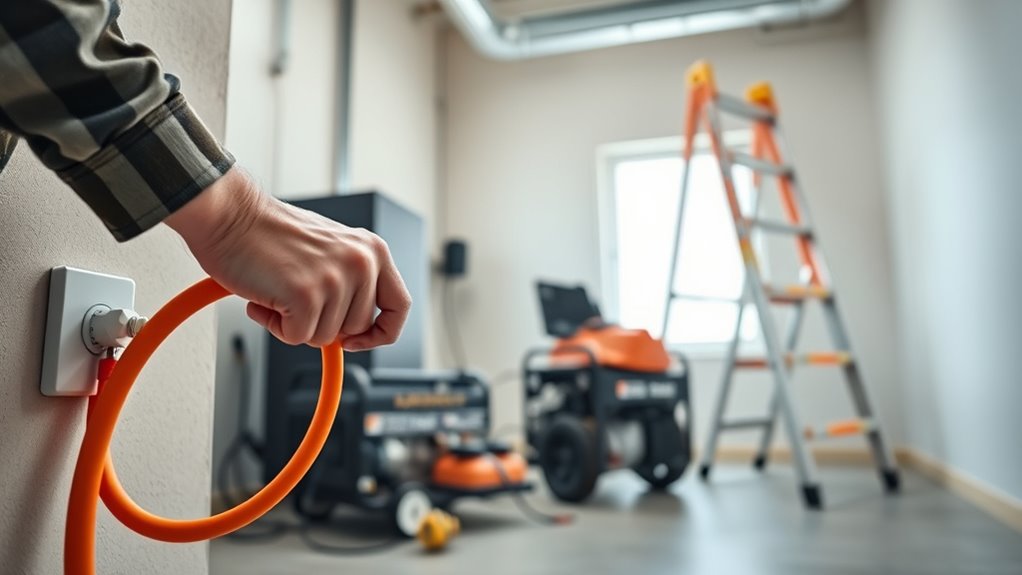
To guarantee safety when connecting and disconnecting extension cords during outages, it’s essential to handle them properly to prevent electrical hazards. Always inspect the cord for damage before use. When connecting indoor lighting, ensure the extension cord length is appropriate—use the shortest cord possible to reduce tripping risks and electrical overload. When plugging in, hold the plug, not the cord, to avoid damaging the connection. When disconnecting, pull the plug straight out, avoiding yanking or twisting. Keep cords away from water and high-traffic areas to prevent accidental disconnection or tripping. Never force a connection or disconnection, and avoid overloading circuits. Following these practices minimizes risks, keeps your electrical system safe, and guarantees reliable power during outages. Regularly checking for damage or wear on extension cords further enhances safety.
Additional Emergency Power Alternatives and Backup Solutions
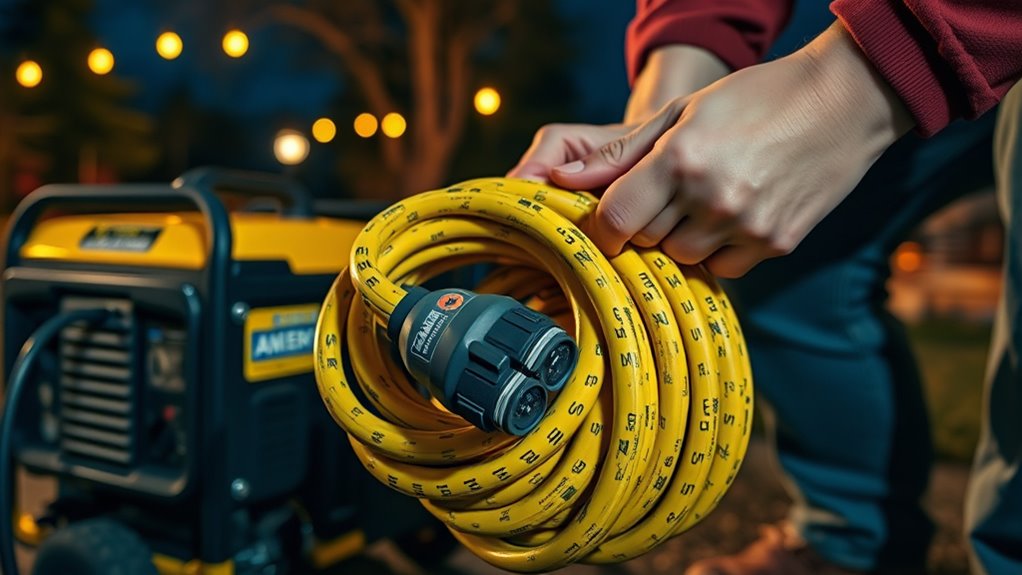
Looking for reliable ways to keep your power on during outages? Consider these backup solutions to stay safe and comfortable. First, solar backups harness sunlight, providing clean, renewable energy that keeps essential devices running. Second, portable generator options offer immediate power, ideal for short-term outages and critical appliances. Third, investing in a standby generator ensures automatic operation during longer outages, giving you peace of mind. Solar backups can be expanded with battery storage, making them more dependable. Generators, whether fuel-powered or inverter types, deliver immediate power but require proper maintenance. Combining solar backups with generator options gives you a versatile, resilient power system that keeps your home running smoothly, even when the grid goes down. Emergency preparedness is key to ensuring continuous power supply during unexpected outages.
Frequently Asked Questions
How Long Can an Extension Cord Safely Be Used During Outages?
You can typically use an extension cord safely for about 50 to 100 feet, but always consider cord length limitations and insulation integrity. Longer cords increase voltage drop and risk overheating, so avoid exceeding manufacturer recommendations. Check that the insulation is intact without cuts or frays. If you need to extend power further, use multiple cords properly rated for outdoor use and avoid daisy-chaining cords to prevent hazards.
Are There Specific Extension Cord Ratings for Outdoor Use During Power Failures?
A stitch in time saves nine, so you should look for extension cords rated specifically for outdoor use during power failures. Outdoor durability matters because these cords are designed to withstand elements like moisture and UV exposure. Pay close attention to the cord gauge importance—thicker gauges (like 14 or 12) handle more current safely. Always choose cords labeled for outdoor use to guarantee safety and reliable performance during outages.
Can Multiple Extension Cords Be Safely Connected Together for Extended Power Needs?
You shouldn’t connect multiple extension cords together for extended power needs because it increases extension cord hazards. Doing so can cause overheating, fire risks, and damage to the cords or connected devices. Always follow safety precautions by using a single, appropriately rated extension cord designed for your power requirements. If you need more power, consider using a heavy-duty, outdoor-rated extension cord or a proper power strip with surge protection.
What Are Signs an Extension Cord Needs Replacement or Repair?
If your extension cord starts showing cord damage or frayed insulation, it’s time to retire it. Don’t ignore the warning signs; damaged cords pose serious shocks or fire risks. If you notice exposed wires or sizzling sounds, replace or repair immediately. Remember, a safe cord is a happy cord. Protect yourself and your home by inspecting cords regularly—because nothing says “I love my gadgets” like avoiding potential hazards.
How Do Temperature Extremes Affect Extension Cord Safety and Performance?
Temperature extremes can seriously impact your extension cord’s safety and performance. Cold weather causes insulation degradation, making cords brittle and prone to cracking, while extreme heat can soften insulation, increasing the risk of shorts or fires. These conditions also reduce cord flexibility, making them harder to handle safely. Always inspect your cords regularly, especially during temperature swings, and replace any that show signs of damage or become stiff and brittle.
Conclusion
Think of extension cords as your trusty bridge during a power outage. When you choose, set up, and inspect them carefully, you keep that bridge stable and safe. Avoid rushing or shortcuts, just like you’d avoid shaky structures. With proper use, your emergency power pathway remains reliable, helping you cross safely through the dark times. Remember, a well-maintained extension cord is your lifeline—strong, dependable, and ready to support you when you need it most.
